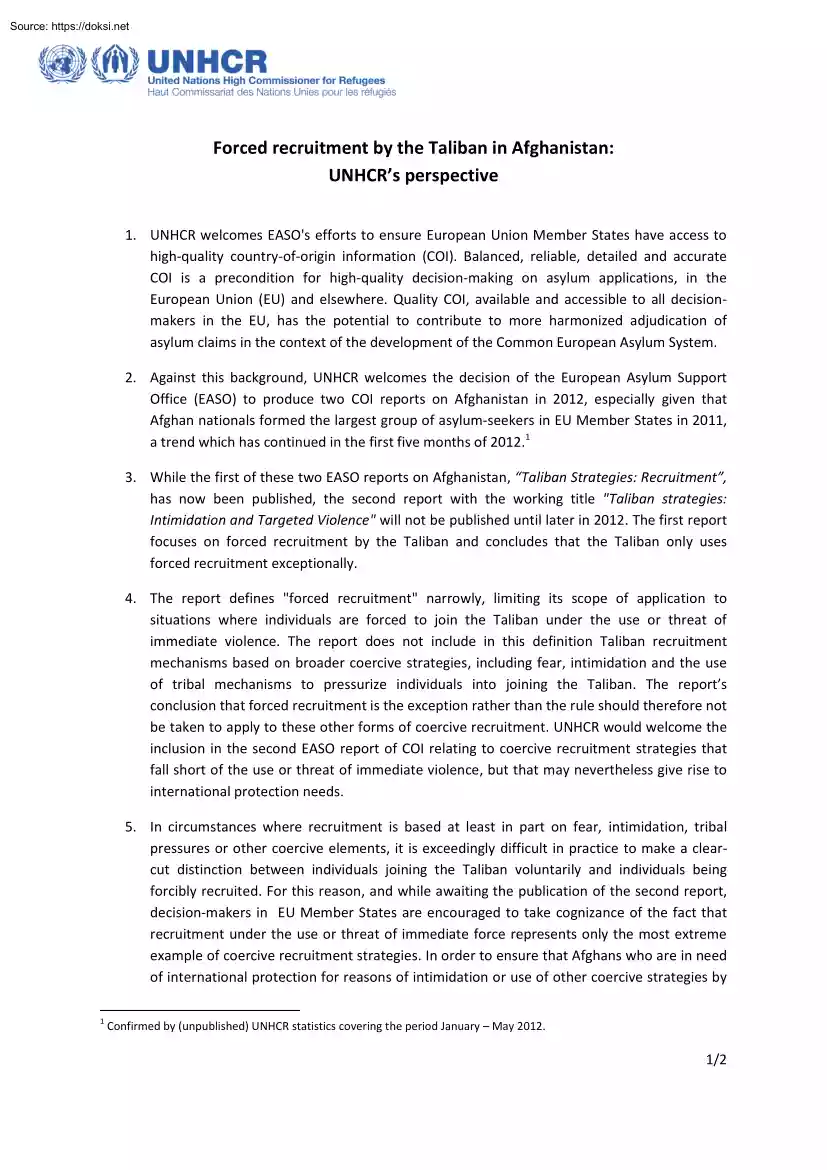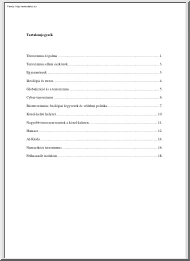Datasheet
Year, pagecount:2021, 2 page(s)
Language:English
Downloads:4
Uploaded:August 19, 2021
Size:886 KB
Institution:
-
Comments:
Attachment:-
Download in PDF:Please log in!
Comments
No comments yet. You can be the first!
Content extract
Forced recruitment by the Taliban in Afghanistan: UNHCR’s perspective 1. UNHCR welcomes EASOs efforts to ensure European Union Member States have access to high-quality country-of-origin information (COI). Balanced, reliable, detailed and accurate COI is a precondition for high-quality decision-making on asylum applications, in the European Union (EU) and elsewhere. Quality COI, available and accessible to all decisionmakers in the EU, has the potential to contribute to more harmonized adjudication of asylum claims in the context of the development of the Common European Asylum System. 2. Against this background, UNHCR welcomes the decision of the European Asylum Support Office (EASO) to produce two COI reports on Afghanistan in 2012, especially given that Afghan nationals formed the largest group of asylum-seekers in EU Member States in 2011, a trend which has continued in the first five months of 2012.1 3. While the first of these two EASO reports on Afghanistan, “Taliban
Strategies: Recruitment”, has now been published, the second report with the working title "Taliban strategies: Intimidation and Targeted Violence" will not be published until later in 2012. The first report focuses on forced recruitment by the Taliban and concludes that the Taliban only uses forced recruitment exceptionally. 4. The report defines "forced recruitment" narrowly, limiting its scope of application to situations where individuals are forced to join the Taliban under the use or threat of immediate violence. The report does not include in this definition Taliban recruitment mechanisms based on broader coercive strategies, including fear, intimidation and the use of tribal mechanisms to pressurize individuals into joining the Taliban. The report’s conclusion that forced recruitment is the exception rather than the rule should therefore not be taken to apply to these other forms of coercive recruitment. UNHCR would welcome the inclusion in the second
EASO report of COI relating to coercive recruitment strategies that fall short of the use or threat of immediate violence, but that may nevertheless give rise to international protection needs. 5. In circumstances where recruitment is based at least in part on fear, intimidation, tribal pressures or other coercive elements, it is exceedingly difficult in practice to make a clearcut distinction between individuals joining the Taliban voluntarily and individuals being forcibly recruited. For this reason, and while awaiting the publication of the second report, decision-makers in EU Member States are encouraged to take cognizance of the fact that recruitment under the use or threat of immediate force represents only the most extreme example of coercive recruitment strategies. In order to ensure that Afghans who are in need of international protection for reasons of intimidation or use of other coercive strategies by 1 Confirmed by (unpublished) UNHCR statistics covering the period
January – May 2012. 1/2 the Taliban receive this protection, the COI contained in the EASO report needs to be read with due consideration to the full range of possible coercive recruitment strategies, including those falling short of recruitment under the use or threat of immediate force. Where Afghan asylum-seekers claim to have fled forcible recruitment by the Taliban, decision-makers in EU Member States will need to identify the precise nature of the coercion of which the applicant complains and decide the case on the basis of the applicant’s individual circumstances. 6. It would be important for EASO, national asylum institutions, lawyers and courts to monitor the use of the report in individual decisions, not least against the background of UNHCR’s findings that procedural standards are not always met in asylum procedures in EU Member States.2 In situations where procedural safeguards are not scrupulously adhered to, a reliance on the EASO report’s conclusions beyond
their limited scope of application may engender a risk that asylum applications of Afghan nationals based on a future risk of coercive recruitment by the Taliban may not be appropriately adjudicated. 7. Decision-makers need to accord due weight to the information contained in the report about forcible recruitment practices by the Taliban in areas of Afghanistan that are under their control, or where they have a strong influence, as well as in areas where social and state protection structures are absent, such as IDP camps in Afghanistan and refugee camps in Pakistan. 8. Decision-makers ought, furthermore, to take duly into account the fact that there is a general lack of access to parts of Afghanistan for journalists, humanitarian workers, human rights observers and others, due to security considerations. As a result, for these parts of the country only limited information about human rights violations is available. In those circumstances, the absence of credible information about
forcible recruitment practices does not necessarily equate to the absence of such practices. The geographical scope of application of the EASO report’s conclusion that forced recruitment happens only exceptionally can therefore only be understood as limited to those areas about which information is freely available. 9. Finally, adjudicators are encouraged to pay particular attention to the meaning of forced recruitment in relation to children, taking in account their susceptibility to indoctrination. Given that the EASO report highlights that indoctrination of Afghan children in madrassas and refugee and IDP camps is widespread, the voluntary nature of decisions by children to join the Taliban is questionable. UNHCR July 2012 2 E.g regarding preparation time before an asylum interview, interview conditions and the use of COI See: UN High Commissioner for Refugees, Improving Asylum Procedures: Comparative Analysis and Recommendations for Law and Detailed Research on Key Asylum
Procedures Directive Provisions, March 2010, available at: Practice http://www.unhcrorg/refworld/docid/4c63e52d2html 2/2
Strategies: Recruitment”, has now been published, the second report with the working title "Taliban strategies: Intimidation and Targeted Violence" will not be published until later in 2012. The first report focuses on forced recruitment by the Taliban and concludes that the Taliban only uses forced recruitment exceptionally. 4. The report defines "forced recruitment" narrowly, limiting its scope of application to situations where individuals are forced to join the Taliban under the use or threat of immediate violence. The report does not include in this definition Taliban recruitment mechanisms based on broader coercive strategies, including fear, intimidation and the use of tribal mechanisms to pressurize individuals into joining the Taliban. The report’s conclusion that forced recruitment is the exception rather than the rule should therefore not be taken to apply to these other forms of coercive recruitment. UNHCR would welcome the inclusion in the second
EASO report of COI relating to coercive recruitment strategies that fall short of the use or threat of immediate violence, but that may nevertheless give rise to international protection needs. 5. In circumstances where recruitment is based at least in part on fear, intimidation, tribal pressures or other coercive elements, it is exceedingly difficult in practice to make a clearcut distinction between individuals joining the Taliban voluntarily and individuals being forcibly recruited. For this reason, and while awaiting the publication of the second report, decision-makers in EU Member States are encouraged to take cognizance of the fact that recruitment under the use or threat of immediate force represents only the most extreme example of coercive recruitment strategies. In order to ensure that Afghans who are in need of international protection for reasons of intimidation or use of other coercive strategies by 1 Confirmed by (unpublished) UNHCR statistics covering the period
January – May 2012. 1/2 the Taliban receive this protection, the COI contained in the EASO report needs to be read with due consideration to the full range of possible coercive recruitment strategies, including those falling short of recruitment under the use or threat of immediate force. Where Afghan asylum-seekers claim to have fled forcible recruitment by the Taliban, decision-makers in EU Member States will need to identify the precise nature of the coercion of which the applicant complains and decide the case on the basis of the applicant’s individual circumstances. 6. It would be important for EASO, national asylum institutions, lawyers and courts to monitor the use of the report in individual decisions, not least against the background of UNHCR’s findings that procedural standards are not always met in asylum procedures in EU Member States.2 In situations where procedural safeguards are not scrupulously adhered to, a reliance on the EASO report’s conclusions beyond
their limited scope of application may engender a risk that asylum applications of Afghan nationals based on a future risk of coercive recruitment by the Taliban may not be appropriately adjudicated. 7. Decision-makers need to accord due weight to the information contained in the report about forcible recruitment practices by the Taliban in areas of Afghanistan that are under their control, or where they have a strong influence, as well as in areas where social and state protection structures are absent, such as IDP camps in Afghanistan and refugee camps in Pakistan. 8. Decision-makers ought, furthermore, to take duly into account the fact that there is a general lack of access to parts of Afghanistan for journalists, humanitarian workers, human rights observers and others, due to security considerations. As a result, for these parts of the country only limited information about human rights violations is available. In those circumstances, the absence of credible information about
forcible recruitment practices does not necessarily equate to the absence of such practices. The geographical scope of application of the EASO report’s conclusion that forced recruitment happens only exceptionally can therefore only be understood as limited to those areas about which information is freely available. 9. Finally, adjudicators are encouraged to pay particular attention to the meaning of forced recruitment in relation to children, taking in account their susceptibility to indoctrination. Given that the EASO report highlights that indoctrination of Afghan children in madrassas and refugee and IDP camps is widespread, the voluntary nature of decisions by children to join the Taliban is questionable. UNHCR July 2012 2 E.g regarding preparation time before an asylum interview, interview conditions and the use of COI See: UN High Commissioner for Refugees, Improving Asylum Procedures: Comparative Analysis and Recommendations for Law and Detailed Research on Key Asylum
Procedures Directive Provisions, March 2010, available at: Practice http://www.unhcrorg/refworld/docid/4c63e52d2html 2/2





 When reading, most of us just let a story wash over us, getting lost in the world of the book rather than paying attention to the individual elements of the plot or writing. However, in English class, our teachers ask us to look at the mechanics of the writing.
When reading, most of us just let a story wash over us, getting lost in the world of the book rather than paying attention to the individual elements of the plot or writing. However, in English class, our teachers ask us to look at the mechanics of the writing.